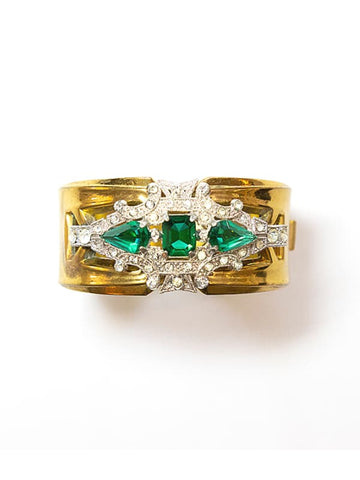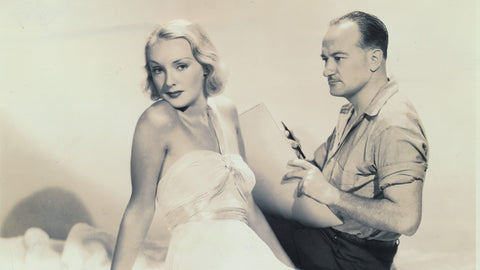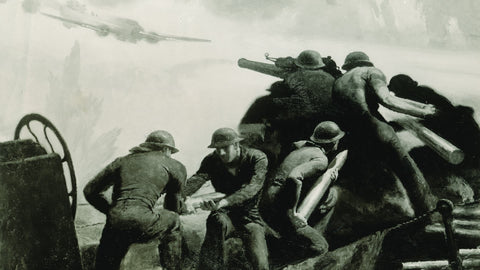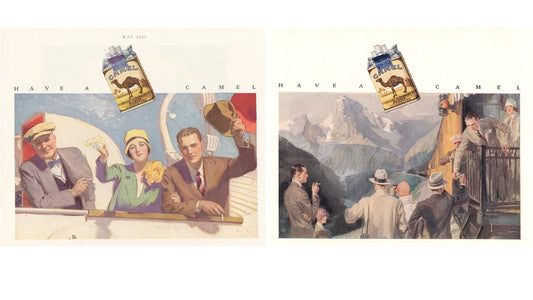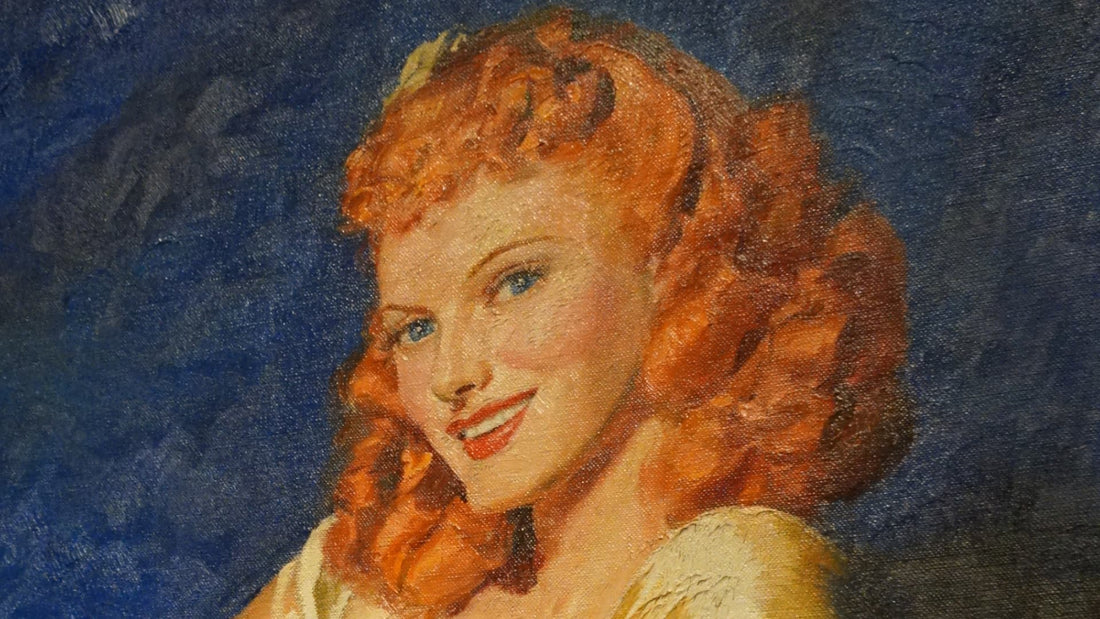
Portrait of a Star: Two ways to see Barclay's painting of Anna Neagle for the film No, No, Nanette
Share
Oscar Wilde observed that, “life imitates art far more than art imitates life”. I think this oil portrait of Anna Neagle painted by McClelland Barclay tests that theory with a work of art that does both.
Today, there are two ways you can see this painting and decide for yourself. Let me explain.
The original Anna Neagle painting
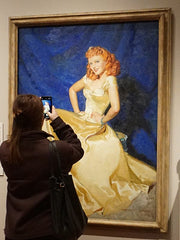
McClelland Barclay painted a large oil portrait of famed British actress, Dame Anna Neagle, D.B.E. She is depicted as her character as Nanette in the film No, No, Nanette. Barclay was commissioned in 1940 to paint it by RKO, the Hollywood film studio.
Neagle is posed coquettishly, hands on hips wearing a golden yellow satin gown. Her coiffed red hair and lips are vibrant against a deep blue background. The painting captures her character in the film: flirtatious and sweet at the same time.
Today, you can see this original Barclay painting on public view at the National Portrait Gallery in London, England. The painting attracts attention, and for some, recognition of the actress. It’s a bright spark among more drab colours, standing out from the stern and serious poses of Royals and other famous people featured in the 2nd floor gallery of 'inspiring people'.
She gets noticed and draws you in. Quite like Nanette in the film. And Neagle in real life.
Barclay's Neagle painting also stars in the film
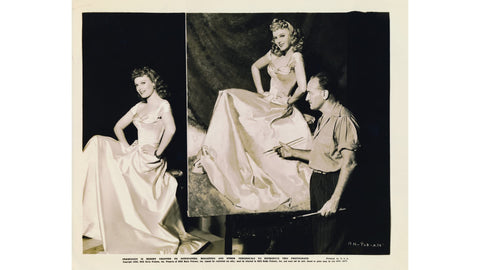 |
L: No, No, Nanette 1940 movie publicity photo of Anna Neagle with McClelland Barclay; R: Screen shot of No, No, Nanette film scene with the same portrait
In my biography of the artist, McClelland Barclay: Painter of Beautiful Women and More, I include the film’s publicity photo on page 56 (above left) showing McClelland Barclay in front of his canvas with Anna Neagle posed beside it.
Not only was this same work of art by Barclay used for the film’s publicity and advertising, it appears in a pivotal role in the film itself. You can view the black and white film directed by Herbert Wilcox, starring Neagle by clicking on the image above, right.
The still image from the film looks remarkably similar, and also features Barclay’s painting! It is from the scene where artist Tom Gillespie (Richard Carlson) works on the canvas while Nanette (Anna Neagle) poses behind it.
The art of imitation
Up until then, Gillespie was stuck making a living as a commercial artist painting scantily clad portraits of women for advertising lingerie or cigarettes, while dreaming of painting a perfect sunset view of Manhattan from his art studio.
The portrait of Nanette is a game changer for them both.
Gillespie’s business manager, Hutchinson (Russell Hicks) reacts with astonishment when he sees it, but then doubts who painted it, saying, “You didn’t do that!” Gillespie agrees, saying “She did,” nodding to Nanette.
Hutchinson, likely thinking of his commission, goes on to say, “Merriwinkles will give five grand for that. It will sell a billion cigarettes!” while indicating the artist would have to “change the background colour and dangle a cigarette from those ruby lips.” Gillespie avoids the unsavory commercial compromise saying the painting is not for sale, it was commissioned by Ms. Nanette Smith.
Seizing an opportunity, Gillespie shows the painting to art dealers. Getting a warm reaction and interest in showing it at top galleries in New York, London, and Boston, he shares the exciting news with Nanette:
It means the Gillespie Girl is dead! And all her world of legs, lingerie, mouthwash. Now I can paint what I want! - Tom Gillespie (Richard Carlson), as the artist in No, No, Nanette, RKO 1940
But meanwhile, Nanette has done something else with the painting, sending the plot in a whole new direction.
Barclay's real life as a commercial artist
This is the part when art imitates life. The painting changes the career trajectory for the film’s artist, similar to McClelland Barclay’s own real life experience breaking free of his typecast. By the early 1930s, Barclay was well known as a commercial “pretty girl” artist for his skill at painting attractive women for advertisers, including Fisher Body Girls, Humming Bird Hosiery and, ironically, Chesterfield cigarettes.
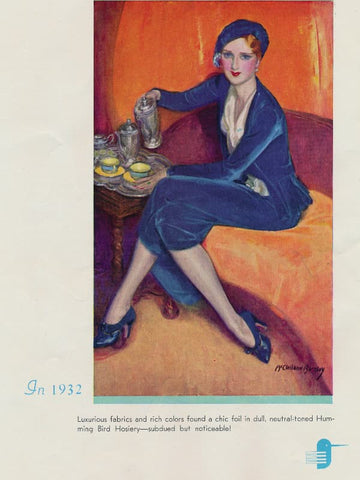 |
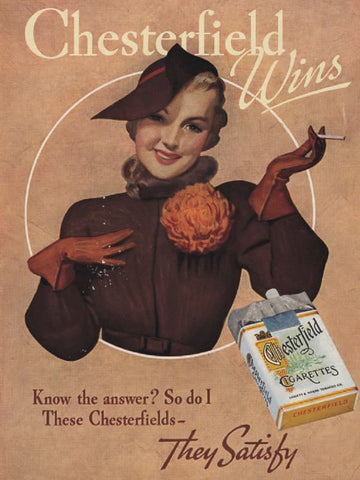 |
McClelland Barclay's 'pretty girl' advertising works, L: Humming Bird hosiery, 1938; R: Chesterfield cigarettes,1936
I write in my book that Norman Rockwell, a contemporary of Barclay’s, even suggested he was destined to only do one kind of illustration work. However, when photography advanced and fewer advertising commissions came his way, Barclay successfully pivoted. Beginning in the early 1930s he illustrated serial stories and many magazine covers. Leveraging his name recognition, he started his own decorative art business, McClelland Barclay Art Products, Inc., and a line of costume jewellery was launched in 1938.
 |
L: McClelland Barclay gold plated with emerald green and clear rhinestone hinged cuff bracelet; R: Barclay's illustration of Lana Turner for the 1941 MGM Zeigfeld Girl movie promotion includes a similar cuff, necklace and earrings.
Barclay also began painting portraits of film stars for Hollywood studios and popular magazines. Continued success as a commercial artist gave him more freedom to pursue his first love of painting landscapes of the ocean, allowing him to hold his first solo exhibit of fine art at the East Hampton Guild Hall in 1937.
The lasting star power of No, No, Nanette
The 1919 My Lady Friends play is a romantic comedy written by Frank Mandel. With Otto Harbach, it was transformed into No, No, Nanette as a popular musical comedy theatre production. Tunes like “Tea for Two” helped its success on stages in Chicago, Broadway and the West End in 1924-25 and beyond. The musical and story line was then adapted for the pre-code silver screen in 1930, and then again in the 1940 version. It has since inspired other movies, and toured on stage in many languages. The musical was successfully revived on Broadway in 1971, in London in 1973 starring Neagle again; and most recently for a short run on stage in Nice in 2020.
The 1940 film version of No, No, Nanette is the somewhat implausible story of a clever young niece who finds a variety of ways to hide her rich uncle Jimmy’s (Roland Young) questionable philandering from his wife (Helen Broderick). Nanette applies creativity and energy to shield the truth, including the sale of her portrait to raise funds. But ultimately her efforts fail. All seems lost, including the affections of the artist Gillespie.
Despite this enduring story and star power, the 1940 film version earned about US$900,000 at the box office and made only a small profit. Variety’s reviews at the time were less flattering because the music barely played a part.
Today, some may find the film to be cringe-worthy for the portrayal of women and not being up to modern production values. But we should remember it was released in late December 1940 when WWII was raging and studios were helping moviegoers escape for 90 minutes with lighthearted romantic comedy.
The National Portrait Gallery website describes the painting as having "the sassy glamour that made Neagle the troops' favourite pin-up." This was the early era of that sexy style of illustration, which some of Barclay’s works were collectively grouped into, despite his being much more demure than other artists. And one must remember this painting was ultimately a commissioned commercial work by a Hollywood studio trying to attract audiences.
Hollywood endings and artistic opportunities
There are several Hollywood-style happy and dramatic endings to this story. First, (spoiler alert), the artist gets the lovely girl by the end of the movie.
In real life, Wilcox had been casting Neagle as leading lady in many of his films since 1932. After their blockbuster success of biopic Victoria the Great (1937), both scored a 10-year contract with RKO and moved to Hollywood in 1939, just as war broke out and film production stopped in England. Wilcox and Neagle returned to London and were married in 1943 (See a 1956 NPG photo of the couple). Neagle and her husband went on to collaborate on numerous other films; but they also fell on financial tough times.
In Paramount's publicity photo for the 1937 musical comedy Artists & Models, Mac is shown painting Sandra Storme.
In another example of art imitating life, McClelland Barclay’s real life Hollywood story saw him in front of the camera painting actress Sandra Storme in the 1937 film Artists and Models. His cinema art also appeared in publicity works for Hotel for Women (1939), Lana Turner in MGM’s Zeigfeld Girl (1941) contest shown above. Perhaps Barclay's most famous pin-up is the illustration he did of Betty Grable for Footlight Serenade (1942).
In considerable contrast, is his naval art used for the poster for Standby for Action (1942). The active combat scene shown below, reflects Lt. Barclay's real-life experience as an artist aboard U.S. Navy ships during WWII.
Barclay's military art was based on his observations aboard naval combat ships. This image was used in the movie poster for the 1942 film Standby for Action
Ultimately however, Barclay’s real life story had a tragic ending. Enlisted in the U.S. Naval Reserve, he was lost at sea in July 1943, when the landing ship he was on was torpedoed by the Japanese in the South Pacific. He had been sketching and painting naval officers, ordinary sailors and USO entertainers to his last day.
Deserving of credits
Both Herbert Wilcox and Anna Neagle are credited for this film, and were also recognized for their lifetime contributions to theatre and cinematic works. Wilcox received the British O.B.E. honour, Dame Anna Neagle received the higher D.B.E. honour in 1969.
The IMdB listing for McClelland Barclay lists a No, No, Nanette film credit for “Camera and Electrical Department” for his publicity photo and his portrait of Miss Neagle (both shown above). Barclay is also listed in the database as an ‘actor’ in the film Artists & Models. The Art Directors Club of New York posthumously awarded him with a lifetime achievement for his advertising and editorial illustrations. The U.S. Navy Naval History and Heritage Command art collection holds Lt. Cmdr. Barclay's original portraits of WWII officers and sketches of sailors and USO entertainers.
I'm not sure if Miss Neagle was given or purchased the portrait of her painted by McClelland Barclay, but The National Portrait Gallery acquired it in 1989. I think McClelland would be delighted that one of his original commercial works is part of the permanent collection hanging in such a prestigious international gallery. But, other than identifying him as the artist, there is little information on the accompanying sign, or on the gallery's website about him.
I think this is a missed opportunity to put the painting, artist, actress, musical and film in context for a new generation of art lovers who may not recognize Anna Neagle, have never seen No, No, Nanette, and most likely know nothing of McClelland Barclay, or WWII for that matter. I hope this story, and my biography of him goes a little way to change that!

